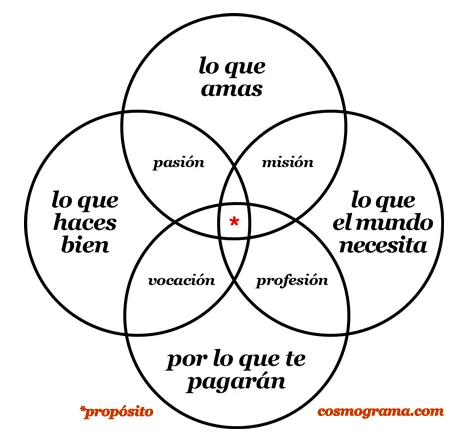You’ve been bamboozled. What you know about “Ikigai” is wrong — dead wrong. And it’s making you choose the wrong things in life.
I hate to break it to you but, Ikigai is not the intersection of:
・what you love
・what you’re good at
・what the world needs
・and what you can be paid for
That’s just a bunch of nonsense started by an uninformed blog post 9 years ago. Do you want to know how it happened?
Most importantly, do you want to know what Ikigai really means and how you can apply it to your life now? Okay, then let’s dive in.
A History of Misinformation
It all started when Marc Winn saw Dan Buettner’s 2014 TED talk on “How to Live to 100+.”
Dan Buettner’s TED Talk on “How To Live To Be 100+”
In the Talk, Dan showed a compelling narrative that having Ikigai is the secret to why many Japanese, particularly Okinawans, live a long and meaningful life.
Marc found “Ikigai” a fascinating idea.
Marc thought “Ikigai” must be the missing link to finding a higher purpose for his entrepreneurial journey.
Without having a clear grasp of the concept of Ikigai, Marc took an interesting Venn diagram from the net, placed the word “Ikigai” in the center, and wrote a blog post on it.
Yes, the original Venn diagram wasn’t Marc’s idea.
A Spanish author named Andres Zuzunaga came up with the idea.
In Zuzunaga’s Venn diagram, the center where all four elements intersect wasn’t explicitly labeled (see below).

Andres Zuzunaga’s original concept “Purpose” Venn Diagram
But Zuzunaga hinted that “purpose” should be in there.
But Marc just took Zuzunaga’s original Venn diagram, stuck the word “Ikigai” in there, and posted it on the net (see below).

Marc Winn’s purported “Ikigai” Venn Diagram
The post went viral and the rest is history…of misinformation.
Check out the original post here.
Besides the key flaw in the article, it’s a good read.
From then on the term Ikigai spread like wildfire and we got Marc Winn to thank for it.
Now, almost all discussions of Ikigai are based on that damn Venn diagram.
Even the most famous book on the subject, “Ikigai: The Japanese Secret to a Long and Happy Life” refers to this crap.
“Ok Denver, let me get this straight. If the thing I thought I knew about Ikigai is not really what it is, then what the f*ck is it then?”
I’m glad you asked.
To answer that question, let’s learn a little Japanese, and then let’s look into Japan’s cultural norms for context.
The 3 Sources of Ikigai
Ikigai is written as 生き甲斐 in the Japanese language.
This word has two parts “iki” (生き) or life, and “kai” (甲斐), or worth.
Combined, this word means one’s “reason for living” or something that’s “worth living for.”
Isn’t this definition a bit strange?
Compared to the Venn diagram above, this definition is quite loose, is it not?
Well, that’s because Ikigai is actually a flexible concept.
Think about it for a minute. What’s “worth living for” to you?
It can be all sorts of things. It can be your work, your family, your writing, your dog, your daily walk — it can be anything!
There is a pattern here of course. Most of the answers generally point to these three aspects of our lives:
・our work
・our relationships
・something we want to be
I call these the “3 sources of Ikigai.”
I also sometimes call them our “3 Life Tasks” because I believe that to live a happy life we need to actively engage in all three of them.
Together, these three paint a better picture of what Ikigai truly means.
But wait, we don’t have the complete picture yet.
We know what the definition says about Ikigai.
But to understand the concept, we will have to know what’s not said in the definition but is well-understood in Japan about the term “Ikigai.”
For that, we’ll have to dig deep into Japan’s cultural traditions.
The 4 Guiding Principles of Ikigai
To make a long story short, here are the 4 main principles behind Ikigai synthesized from Japanese cultural norms:
- Starting Small
- Living in Harmony
- Sustainable Living
- Living in the moment
Think of it this way. Your Ikigai flourishes when you engage with it using these 4 principles.
In the words of Ken Mogi, a contemporary Japanese intellect, these are the “pillars” that make Ikigai possible. He even wrote a book on it called “The Little Book of Ikigai” — it’s required reading for anyone interested in the subject.
Principle #1: Starting Small
When the Japanese engage with their Ikigai the “pressure to succeed” is not an issue.
The journey itself is what matters.
They don’t rush things — like they have all the time in the world.
Enjoying the little things is the true path to mastery.
Starting small is about learning the fundamentals and growing from small beginnings.
Tell me, which would give you more meaning, buying a million-dollar company or building one from the ground up?
The same is true for your Ikigai, you grow it from small beginnings.
Principle #2: Living in Harmony
Another unwritten rule for having Ikigai is that one is engaging in it while in harmony with the rest of the world.
There is a saying, “You can live however the f*ck you want, just don’t hurt other people.”
For the Japanese, that goes for the natural world as well.
It would be difficult to claim, “I’m a thief and stealing is my Ikigai.”
No, if what you’re doing hurts people, then it may have nothing to do with Ikigai, but all to do with being a sociopath.
In principle, having Ikigai means being in alignment with other people and the world.
Principle #3: Sustainable Living
This principle points to living a simple life based on the values of conservation and humbleness.
Japan teaches children how to conserve resources and be humble at a young age. These values serve as checks against consumerism.
You see, consumerism is an act to get external validation ー a great source of unhappiness for many people.
Sustainable living is to be contented with what’s “enough.”
If you have your Ikigai, you don’t need external validation.
Your Ikigai is complete in and of itself.
Principle #4: Living in the moment
The Japanese are great at getting lost in “the flow” with what they’re doing no matter how mundane it is.
You see, to the Japanese, living with Ikigai means enjoying the moment with their work, their loved ones, and the task at hand.
This is essentially what Ichigo-ichie means:
“We must value each moment as they occur, since they may never come this way again.”
If it’s “worth living for,” then all the more you have to pay close attention to it, since it’s your life passing in front of you.
Don’t Wait, Live with Your Ikigai Now
You now have the complete picture of what having “Ikigai” truly means.
Both the “3 sources of Ikigai” and the “4 guiding principles” behind the concept are the only things you need to know to live a meaningful and happy life.
Forget about that damn Venn diagram — it will just confuse you.
Instead, create your Ikigai by simply
・improving yourself
・building meaningful relationships
・attempting to contribute to the world
Then apply the following 4 guiding principles to your life tasks:
・start small
・live sustainably
・be present and in the moment
・live in harmony with the world
Contrary to what others would have you believe, Ikigai is a simple concept that’s accessible to all.
If you engage with your life tasks and live by these principles, there’s no reason why you can’t have a meaningful life right now.
So don’t wait and live your life now according to your Ikigai, perhaps you’ll have a long one, too. I’ll cross my fingers for you.
・ ・ ・
Join my newsletter for more ideas like this and get a free Ebook on how to set meaningful life goals. I‘m also active on Twitter (X) so if that’s your thing, let’s connect here.
 Ikigai Notes Carry out your Life Tasks, Discover your Ikigai, Engineer your own Destiny
Ikigai Notes Carry out your Life Tasks, Discover your Ikigai, Engineer your own Destiny





